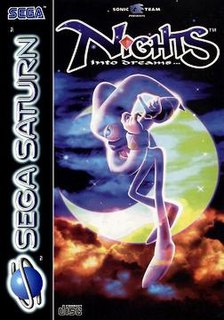
Nights into Dreams is a 1996 action game developed by Sonic Team and published by Sega for the Sega Saturn. The story follows teenagers Elliot Edwards and Claris Sinclair, who enter Nightopia, a dream world where all dreams take place. With the help of Nights, an exiled "Nightmaren", they begin a journey to stop the evil ruler Wizeman from destroying Nightopia and consequently the real world. Players control Nights flying through Elliot and Claris's dreams to gather enough energy to defeat Wizeman and save Nightopia. The game is presented in 3D and imposes time limits on every level, in which the player must accumulate points to proceed.
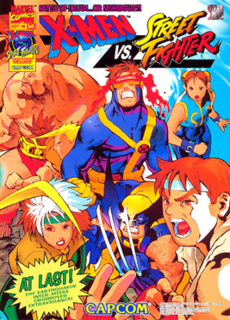
X-Men vs. Street Fighter is a crossover fighting video game developed and published by Capcom. It is Capcom's third fighting game to feature Marvel Comics characters, following X-Men: Children of the Atom and Marvel Super Heroes, and the first installment in the Marvel vs. Capcom series. As the title suggests, the game includes characters from Marvel's X-Men franchise and the cast from Capcom's Street Fighter series. Originally released as a coin-operated arcade game in 1996, it was ported to the Sega Saturn in 1997 and the PlayStation in 1998.
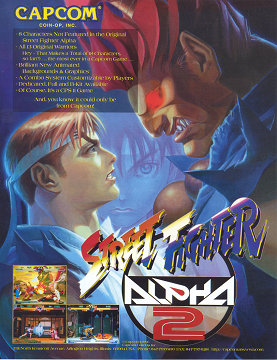
Street Fighter Alpha 2 is a 1996 fighting game originally released for the CPS II arcade hardware by Capcom. The game is both a sequel and a remake to the previous year's Street Fighter Alpha: Warriors' Dreams, which is itself a prequel to the Street Fighter II series in terms of plot and setting. The game features a number of improvements over the original, such as new attacks, stages, endings, and gameplay features. It was followed by Street Fighter Alpha 3.

X-Men: Children of the Atom is an arcade game that was produced by Capcom and released on the CP System II arcade hardware in 1994 in Japan and in 1995 in North America and Europe.

Pandemonium! is a 1996 platform video game developed by Toys for Bob and published by Crystal Dynamics for the PlayStation, Sega Saturn, Microsoft Windows, N-Gage, Mobile and iOS. Pandemonium! features Fargus, a joker, and Nikki, a sorceress, who unwittingly casts a spell that destroys the town. The goal of the game is to reach the Wishing Engine, where they can wish the town back to normal. For each level, the player can choose which character to be. Each has a special move – Fargus can deliver a special spinning attack, and Nikki can double jump. The game consists of a great variety of unique gameplay objects, such as watermelons, clouds, spider webs and logs. A sequel, Pandemonium 2, was released in 1997 for PlayStation and Microsoft Windows.

Marvel Super Heroes is a fighting video game developed by Capcom. Originally released in the arcade in 1995 on the CPS-2 arcade system, it was ported to the Sega Saturn and PlayStation in late 1997. The game, alongside Marvel vs. Capcom: Clash of Super Heroes, was also included in the Marvel vs. Capcom Origins collection, released digitally for the PlayStation 3 and Xbox 360 in September 2012.

Mega Man 8 is an action-platform video game developed and released by Capcom in 1996. It was directed by Hayato Kaji, who had previously worked on the series as an artist. Keiji Inafune, who was also an artist for the series, was given the role of producer after the departure of Tokuro Fujiwara who had been producer for the series since Mega Man 2. It is the eighth installment in the original Mega Man series, and was initially released in Japan on the PlayStation in 1996. The following year, Mega Man 8 saw a release on the Sega Saturn and was localized for both consoles in North America and the PlayStation alone in PAL regions. Mega Man 8 is the first game in the series made available on 32-bit consoles. The plot begins as the humanoid robot Mega Man is called to investigate an energy reading coming from a recent meteor crash on an island. Mega Man discovers that his nemesis Dr. Wily has ran off with the energy source. Mega Man is charged with stopping Wily's evil plans to use the energy, and discovering the purpose of a mysterious, alien robot found at the crash site.
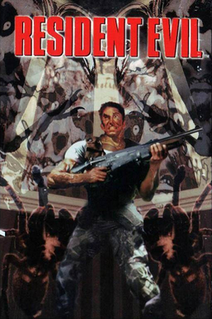
Resident Evil is a survival horror video game developed and released by Capcom originally for the PlayStation in 1996, and is the first game in the Resident Evil series. The game's plot follows Chris Redfield and Jill Valentine, members of an elite task force known as S.T.A.R.S., as they investigate the outskirts of Raccoon City following the disappearance of their team members. They soon become trapped in a mansion infested with zombies and other monsters. The player, having selected to play as Chris or Jill at the start of the game, must explore the mansion to uncover its secrets.

Fighting Vipers is a 3D fighting video game developed by Sega AM2. It uses the same game engine as AM2's Virtua Fighter 2 but features enclosed arenas and an armor mechanic, and was targeted more towards Western audiences, using a U.S. setting and more freeform styles of martial arts. The game was released in the arcade in 1995 using the Sega Model 2 hardware, and became one of the highest grossing arcade games of 1996. The game was ported to the Sega Saturn, and to PlayStation Network and Xbox Live Arcade in 2012. Though Fighting Vipers was not very popular in arcades, the Saturn version was one of the most high-profile games in the system's 1996 holiday lineup, and was met with positive reviews.
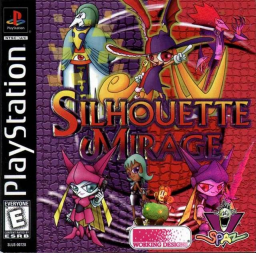
Silhouette Mirage is a 2D action side-scrolling video game developed by Treasure and released in 1997. The game's primary mechanic is the two opposing attributes, "Silhouette" and "Mirage" and the way they are able to cause damage to each other. Shyna features as the female protagonist who is able to switch between these attributes at will by facing either left or right on-screen. Secondary mechanics in the form of various melee moves are used to get enemies onto the correct side of the screen so that when Shyna is facing them, she is able to use the correct, opposing attribute to damage them.

Batman Forever: The Arcade Game is a beat 'em up video game based on the movie Batman Forever. The subtitle is used to differentiate it from Batman Forever, another beat 'em up published by Acclaim. One or two players, playing as Batman and Robin, fight Two-Face, the Riddler, and numerous henchmen.

Puzzle Bobble 3 is an action puzzle video game developed by Taito. The second sequel to Puzzle Bobble, it was released for arcades in September 1996 and later ported to the Sega Saturn, PlayStation, Game Boy, Nintendo 64 and Microsoft Windows. Like its predecessors, the player is tasked with shooting balls at groups of balls, creating groups of three or more, which are then removed from play.

Herc's Adventures is a video game released for the PlayStation and the Sega Saturn by LucasArts in 1997. The overhead, action-adventure format is similar to Zombies Ate My Neighbors. Up to two players each take on the role of one of three ancient Greek heroes: Herc (Hercules), Atlanta (Atalanta), or Jason, who are on a quest to defeat Hades and save the goddess of nature, Persephone. In 2014, it was released for PSN in North America.

Return Fire is a 1995 video game developed by Silent Software, Inc. for the 3DO Interactive Multiplayer and ported to the PC and PlayStation in 1996. It was preceded by Fire Power (1987) and followed by Return Fire 2 (1998). An expansion pack, Return Fire: Maps O' Death, was released for the 3DO in 1995. Return Fire is a vehicular shooter from a 3D bird's eye view, in which the player's goal is to capture the enemy flag and return with it to their base. It was met with critical acclaim for its unusual gameplay concept, enjoyable multiplayer mode, and classical soundtrack, and is remembered as one of the 3DO's "best games" in its Home of the Underdogs entry.

Night Warriors: Darkstalkers' Revenge, known in Japan as Vampire Hunter: Darkstalkers' Revenge, is the second game in the Darkstalkers fighting game series, developed and released by Capcom for the arcades in 1995. Night Warriors was ported for the Sega Saturn home console in 1996, receiving a generally very positive critical reception, especially for its smooth and detailed animation. The game was also included in the Darkstalkers series compilation release Vampire: Darkstalkers Collection in 2005 and was remastered as part of Darkstalkers Resurrection in 2013. It was followed by Darkstalkers 3 in 1997.

Loaded is a science fiction-themed top-down shoot 'em up video game that was developed by Gremlin Interactive and published by Interplay Productions. Loaded was released on December 12, 1995 on the PlayStation, and was ported to the Sega Saturn the following year. The game had origins in DC Comics as well as the more adult-orientated Vertigo Comics, and there was a small graphic novel based on the game. The six playable characters of the game are a combination of villains, anti-heroes, psychopaths, perverts, mutants, and flamboyant murderers. They are, however, the best hope to stop the intergalactic supervillain nicknamed F.U.B. and save the universe. The characters were created and designed with contributions from Garth Ennis of Vertigo Comics and Greg Staples of 2000AD.

Krazy Ivan is a mecha first-person shooter released for PC, Sega Saturn and PlayStation in 1996 by Psygnosis.

Street Fighter Alpha: Warriors' Dreams is a 2D 1995 fighting game by Capcom originally released for the arcade for the CP System II hardware. It was the first all new Street Fighter game produced by Capcom since the release of Street Fighter II in 1991. The working title for the game was Street Fighter Legends.

CrimeWave is a vehicular combat video game, developed and published by Eidos Interactive, released as a Sega Saturn exclusive in 1996.
X-Women: The Sinister Virus is an unreleased side-scrolling action video game that was in development by Clockwork Tortoise and planned to be published by Sega on a scheduled January 1997 release date exclusively for the Sega Genesis. Based on the popular X-Men Marvel Comics superheroes, it is inspired by the long-running comic book mythology and adaptations in other media. In the main storyline, a plot to incapacitate all male mutants by inflicting a disease known as the Genesis Virus upon them was orchestrated by Mister Sinister, leaving only the X-Women to scour through Earth in order to find the remaining viruses and develop a cure.



















